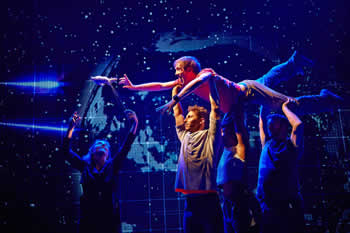HotReview.org Editor's
Picks
Shows Worth Seeing:

The Curious Incident of the Dog in the Night-Time
By Simon Stephens
Ethyl BarrymoreTheater
243 W. 47th St.
TICKETS
The use of disability in the theater ought to make audiences uncomfortable, especially given the sad history of exploiting it for sensationalism, as in circus sideshows. Of course most disability in theater isn’t literal, as in sideshows, but rather enacted, and usually the artists involved are sincerely convinced they’re offering real insights into poorly understood conditions and generating public sympathy. That’s true even of sentimental pop vehicles like Rain Man and dramas conceived as tour de force acting vehicles like Elephant Man.
Simon Stephens’s play The Curious Incident of the Dog in the Night-Time, based on Mark Haddon’s novel about an autistic boy—a long-running hit in London now reconceived for Broadway—wears its good intentions prominently on its sleeve. Employing a high-tech theatrical vocabulary that amazes, impresses and intimidates, it seeks to generate sympathy and understanding not just through external enactment of autistic behavior but by representing autism’s inner experience. Complex and ingenious light and projection effects simulate confusion and alienation in the face of difficult phenomena like close physical contact and metaphorical language. Maps and diagrams drawn by the protagonist Christopher Boone (Alex Sharp) are replicated instantaneously on the set’s walls. Cleverly choreographed movements (actors tumbling in place, or held aloft to walk along walls) simulate the effect of emotions like anxiety, grief and fear that Christopher can’t express outwardly. This is a drama, in other words, in which disability becomes a tour de force directing and design vehicle.
I don’t say that damningly or cynically but rather with due respect for the imagination, sensitivity and technical expertise brought to bear by director Marianne Elliott, scene and costume designer Bunny Christie, video designer Finn Ross and the choreographic team of Frantic Assembly. I do say, however, that I found it hard to think about how sympathetic this play was to autism, or how accurately it might represent autistic experience, because I was too busy squirming at the thought of thousands of people applauding such a virtuosic imitation of that experience. Were my feelings the productive sort of discomfort we ought to have in the face of theatrical disability, or the unproductive sort? I’m not sure myself.
